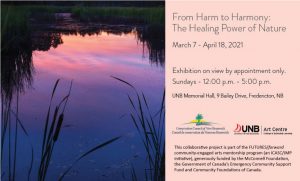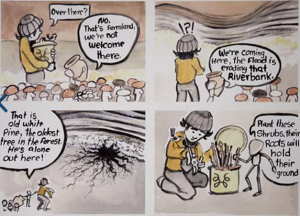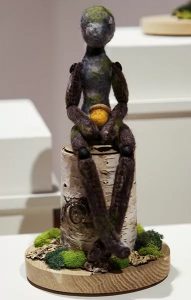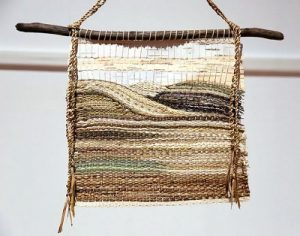FUTURES/forward Mentorships: Featuring Juliana Bedoya
FUTURES/forward Mentee, Juliana Bedoya — cohort #3 triad, October 2020 to March 2021 — mentored by Seanna Connell
As part of the triad model, Juliana was placed as an artist-in-residence at the Conservation Council of New Brunswick (CCNB).
The community-engaged arts project co-created with CCNB: From Harm to Harmony: the healing power of nature, a series of visual arts workshops hosted virtually.
With a background in contemporary sculpture and installation, JULIANA BEDOYA is a community-engaged environmental visual artist who explores plant technologies to creatively connect with the local landscape and to cultivate reciprocal and interconnected relationships with the land and people. Her work aims to support individuals and community groups to establish their own cultural significance through skill sharing, including all stages of ethically harvesting and processing raw plant materials for art-making and environmental art practice. Using ancestral skills and traditional knowledge that navigates across cultures and mainly working with green waste and invasive plants, her work also aims to support local ecological restoration to foster native ecology. Alongside this practice, for the past ten years, she has worked in the non-profit and public sectors as a curator and arts administrator developing interactive exhibitions, public art installations, and delivering arts programming that activates diverse audiences to support community participation.
THE MENTORSHIP
Theory Put Into Practice, In Real Time
 Once Seanna Connell and I were paired up and connected with the Conservation Council of New Brunswick (CCNB), we decided to meet on a video call for one hour every week.
Once Seanna Connell and I were paired up and connected with the Conservation Council of New Brunswick (CCNB), we decided to meet on a video call for one hour every week.
We started by creating a list of aspects, themes, and topics about community-engaged arts for social change (ASC). Each week we would decide upon the topic we were going to explore and discuss the following week. Seanna prepared for each discussion and found resources, examples, or case studies to share with me. We also created a shared document to use as a collaborative tool to add discussion content. This has become now a very robust document full of information and resources that will be very useful for future reference.
During our weekly meetings we would exchange our experiences and knowledge on each topic and often our topics coincided with what was going on in the project, making them extra relevant. It was “theory” put into practice, in real time.
This mentorship differs from other types of learning, from classroom or academic learning, from student placements or field work, and is about working synchronically on a real-life project, with the ongoing support and guidance of someone with experience in the field.
Working with a mentor and having someone to bounce off ideas, sharing responsibility, not working alone, and the ongoing true collaboration, provided a format that is ideal for community-engaged work. Not being alone mentally and emotionally with the project and hearing examples that were relevant was extremely valuable, issues that likely had happened to my mentor before and could be worked through.
This remote format, specifically during a pandemic, worked really well in a digital environment. It is not only a good alternative to in-person facilitation, it is also customized for one artist, checking in on a weekly basis and going over all the topics while carrying out a specific community- engaged arts project. It has been amazing to do this work remotely with a mentor in Toronto, the environmental organization and participating artists in New Brunswick and the facilitating artist in Vancouver Island. Because of Canada’s geographic size, online mentorship brings people together, it’s inclusive and accessible, one doesn’t need to travel to a site or school to learn and practice.
“Many arts organizations have pivoted and moved their in-studio, direct service in community-engaged work online onto digital forums due to the pandemic. There has been great innovation and creativity in this period. There has also been rapid learning about how to connect digitally and do community-engaged arts projects online, many of which were previously done in person, on site. Many of this will likely continue on past the pandemic, as there are benefits to it. That said, we don’t think it can replace the value of in real life, in person, in community gatherings. Perhaps, after the pandemic, there will be a hybrid of the two ways of working: digitally and in real life.” Seanna Connell
Both Seanna and I think that the mentorship approach is an excellent way of learning. That this model — one in which there is a mentee, mentor, as well as a host organization, and a duration of time in which to work on a community-engaged arts project — is a great way to introduce the mentee to the inner workings of community-engaged arts with the support and guidance of a mentor and introduce the host organization to community-engaged arts as well.
BEING A MENTEE
How this mentorship changed and supported my practice
I started this mentorship coming from a place of not feeling very confident, not having facilitated anything online ever before, and also a bit disoriented from recently losing my job as an arts programmer due to COVID. I gained a lot more confidence as a community-engaged artist and reassurance in the processes and methodologies I was implementing as I was checking in with Seanna and seeing the group being so responsive and receptive.
 This has been one of the most successful community art projects I have facilitated at all levels. The fact that I had a “real-time” mentor who could provide feedback, thoughtful insights, direction and resources responding to the real-time needs of the project was an ideal scenario to do this kind of work. After doing this work this way, it is hard for me to imagine that a different model could provide the same degree of engagement, results, and responsiveness to custom made and tailored needs.I practiced letting go of my agenda as an artist realizing that it was not important, and it could adapt with the group working together and co-creating with them. My agenda didn’t need to be carried out completely. Also, my own levels of anxiety around climate change diminished as we collectively shared and spoke about them.It was also very useful to have previous experience in curatorial practice, exhibition design, arts programming, production, and existing project management skills that I wasn’t sure would be needed. This emerged so naturally as a useful asset and helped us maximize the time together with the group to do the work efficiently and tactfully without sacrificing quality and depth of our conversations online and offline.WORKING WITH THE ENVIRONMENTAL ORGANIZATION
This has been one of the most successful community art projects I have facilitated at all levels. The fact that I had a “real-time” mentor who could provide feedback, thoughtful insights, direction and resources responding to the real-time needs of the project was an ideal scenario to do this kind of work. After doing this work this way, it is hard for me to imagine that a different model could provide the same degree of engagement, results, and responsiveness to custom made and tailored needs.I practiced letting go of my agenda as an artist realizing that it was not important, and it could adapt with the group working together and co-creating with them. My agenda didn’t need to be carried out completely. Also, my own levels of anxiety around climate change diminished as we collectively shared and spoke about them.It was also very useful to have previous experience in curatorial practice, exhibition design, arts programming, production, and existing project management skills that I wasn’t sure would be needed. This emerged so naturally as a useful asset and helped us maximize the time together with the group to do the work efficiently and tactfully without sacrificing quality and depth of our conversations online and offline.WORKING WITH THE ENVIRONMENTAL ORGANIZATION
Throughout the six months of this mentorship, CCNB was very responsive. They had the necessary involvement as an organization and gave me the creative freedom as the facilitating artist to lead the project as I considered appropriate and necessary.
Starting the process with the asset mapping of this 50-year-old environmental organization, the community and each participant maximized our time identifying the existing individual and shared resources available to be used in the project.
We inquired: What were the existing community partners? Who were the artists in the mix? What was their access to resources and materials? What was their digital capacity? Who were the decision makers? What art did they like making? What were people already doing? Who was not at the table? What knowledge did participants have in a particular area like environmental issues, history of their community, climate change, etc.? What were they willing to teach/share with others (e. g. admin, photography, drawing, video, writing, etc.)? And lastly, what were the passions that stirred them to action specifically around climate change?
PRELIMINARY WORK WITH THE CONSERVATION COUNCIL OF NEW BRUNSWICK

The strong foundation we established with the environmental organization at the beginning of the project helped us identify the pressing issues and existing opportunities that would lead our sessions with the community, including:
- Engaging people affected by eco- anxiety to generate a deeper level of engagement and creating emotional connections that would lead to action.
- We identified the ideal audience making this initiative available to a combination of existing CCNB supporters or working groups and not so engaged new supporters across the province.
- We also identified possible community partners including the UNB Art Centre as a potential exhibition space.
- We came up with the wording Action over Worry as our project mantra and philosophy from beginning to end.
THE PROJECT
Community-Engaged Arts Skills and Techniques Used in This Project
We started our community engagement by creating an open call inviting people to participate. We used a “How Might We” question or “challenge mapping” approach from IDEO’s Design Thinking that helps groups to re-frame a problem in a way that invites others to think on it and take action. This was our call inviting the community to participate: How might we express our ideas or feelings about climate change through art?
My approach to community organizing in this project was not to lead, not to walk from behind, but to bear witness and walk with the community. This project was also designed to engage “heads, hands and hearts” to create dialogue and positive environmental action, moving from a discourse loaded with eco-anxiety to empower participants to take a more hopeful and action-driven approach around climate change.
We made additional effort to connect with other groups that weren’t initially represented in the group and invited guest speakers like Charlie Gaffney, an Indigenous artist from Mawi’Art, Thandiwe McCarthy, an artist representing The New Brunswick Black Artists Alliance and a family of ESL newcomers to be part of the project, either as participants or guest speakers.
Even though our project had a very specific tangible outcome with an invitation to exhibit the resulting work at the UNB Art Centre, and a tight timeline outlined and agreed upon from the beginning of the project, we spent a big portion of our engagements building a strong foundation of relationship and trust. Only later in the process we started to speak about specific tangible outcomes and the creation of artwork for the show. This project was about time and needed 10 weeks of engagements to build trust, starting with the environmental organization and then with the group. This allowed for the depth that wouldn’t have happened otherwise. The logistics needed the time to happen this way too.
All the work, being this individually generated or collectively produced was envisioned as a collaborative and participatory process. This strong foundation generated a lot of synergy in the group and a dynamic cross-germination among participants for the creation of the artwork (e. g.: the felted characters made by one participant from a comic story that another participant created, the pinecones project, etc.). The ongoing collaborative ideation process involved the art of plussing people’s ideas, saying “Yes, And…” while brainstorming, inviting everybody to get their ideas out without being criticized. This created an environment where everyone had the chance to shine, the strength of the group, the ensemble as opposed to the individual.
Having experts in the group on climate change issues and other environmental disciplines made the experience an ongoing shared learning for everyone. Inspired by the techniques used by John O’Neal and JuPong Lin’s Community Story Circle structure, we carried conversations that allowed us to vent and express our emotions around climate change issues. Having experts in the group on climate change issues and other environmental disciplines made the experience an ongoing shared learning for everyone.
We accepted people’s contributions addressing where people were, e. g.: Fred Harrison who lives in rural NB joined the project without access to the internet and created the What If All the Trees Died project working with students from the Sussex Regional High School. Even if people couldn’t attend the Zoom meetings, they were still welcome to participate.
In my opinion, one of the most important aspects that contributed to the success of this community art project was being responsive at all times with all the ongoing communications and the project management component using collaborative platforms like Google docs, Miro, Asana, Typeform, Facebook Messenger, and other more accessible ones for people without access to the internet like text messages from a Cell phone or just a phone call. Providing all possible outlets for people to communicate their ideas and a diverse array of artistic mediums to materialize their projects was a key element throughout the whole process.
KEY ACCOMPLISHMENTS
The environmental crisis can be paralyzing, and I was so happy to see as a facilitating artist how our community-engaged art process helped us move from a place of eco-anxiety, feeling burdened with hopelessness and impossibility, to feeling more equipped and excited about the possibility of communicating an important message using our existing creative outlets.

Seeing the principles of ASC in practice in such a tangible way, taking a project from beginning to end: getting the group to work together and trust the process, trust the state of ambiguity by having something in common not necessarily knowing the final outcome; and listening to each other. There was doubt at the beginning for some participants, but holding the group, coaching, and reassuring people that this was a process was a highly effective strategy to maintain engagement.
Creating working committees and leadership in different areas among the group (writing, photography, video editing, story illustrations, paper mache, embroidery and rug hooking, weaving with plants, etc.) allowed for the project management to be a shared responsibility and was a very effective and efficient way to work collaboratively while meeting deadlines and shipping deliverables.
This project not only materialized in an amazing professional display, it also provided a safe space to voice our concerns, it generated a hopeful sense of agency after dealing collectively with these emotional issues. Having experts in the group on climate change issues and other environmental disciplines made the experience an ongoing shared learning for everyone. For everyone involved it was also a great accomplishment to have the opportunity to exhibit the work professionally displayed at UNB Art Centre.
People inspired each other and put their best work forward and having the exhibit space made things fall into place. Using a “focus on the positive”, “we can do this”, “we got this” approach and our Action Over Worry mantra, we managed to overcome the feeling of “this project is too big to handle” to realize it and make it happen.
We have a collection of powerful stories and testimonials addressing the power of community arts and the healing process some participants experienced around their eco- anxiety caused by the climate emergency. Participants are more confident in their own creative practice and advocacy as climate activists. Please read their quotes and testimonials here.
“For CCNB the key accomplishments of this project were the products and the outcomes like the partnership with the UNB Art Centre and art show. They feel through the project CCNB helped their supporters and project participants deal with ecological grief through art and community. They now have a strengthened network, a positive story, and a way to communicate environmental issues like climate change. This project helped them to continue their path toward “love- based” engagement on climate change. CCNB is pleased that professional artists as well as emerging artists wanted to participate. Louise Comeau, Director of the Conservation Council’s Climate Change and Energy Solutions Program
Another positive outcome of this project were the effective community partnerships with CCNB, UNB Art centre, Mawi’ Art, NB Association of Black Artists and other groups that were engaged by project participants (e.g.: AK family and the Sussex Regional High School). Both the organization and community participants want continuity of the work and are looking for ways to do so finding funding sources, existing partnerships, etc. There were some projects we discussed that participants are starting to develop like working with a nursing home and a preschool, publishing the comic book and using it as a teaching tool and other exciting ideas and collaborations are emerging. We are currently submitting the work created to a call for work organized by the University of Massachusetts Amherst for their Creative Women Leading Climate Action Virtual Symposium.
UNEXPECTED SURPRISES
This project worked out better than we thought possible and exceeded our expectations. Given the pandemic, working completely digitally with no experience as a remote arts facilitator, working with people we’ve never met before, many of whom did not know each other either, in a short time period, with limited resources. We evidenced artistic richness and depth coming out of a global crisis and people adapted so well to working this way.
The responsiveness of the environmental organization surpassed our expectations too. They trusted the process 100% and always got involved to facilitate things when needed, e.g.: initial goal setting meeting, setting up the call to participate up on their website, liaising with other community organizations, promoting the exhibition, proofreading material, paying fees to guest speakers invited to the sessions, paying for materials and postage to ship the artwork to the UNB Art Centre and to retrieve it back to the artists, etc.
CHALLENGES
- A very tight timeline: a lot was accomplished in a very short timeframe and even with a lot of excitement, that made me and some of the participants feel a bit stressed out.
- Digital challenges: I tried different platforms but ended up coming back to the most simple and accessible, keeping things simple, using simple technologies.
- There was a learning curve for me, overcoming technological challenges specifically with Zoom. The video didn’t work the first session and it was very stressful for everyone. I thought people would not stick with me, but we worked through the digital challenges.
- One big realization for me was to see that online technology doesn’t need to be incredibly sophisticated to be effective; actually, the opposite proves to be true, the more simple the tools, the more effective and the more accessible it will be.
- As an artist, it was hard to do the project while looking after, full-time, a breast-fed toddler with very reduced, or non-existent, options for childcare. I did most of the work for this project while my son was sleeping at night or napping.
- For me, moving to a different city in the middle of the big crunch in production of the show was something I thought would negatively affect the end result; on the contrary, it empowered people to lead their own work committees and deliver their components to the project by the agreed deadlines.

IMPORTANT PROJECT LINKS
Recorded Webinar — Experience the Power of Art to Inspire Climate Action — where environmentalists from participating organizations talk with artist and participants about their experiences in FUTURES/forward community-engaged arts projects: https://www.conservationcouncil.ca/recorded-webinar-the-power-of-art-to-inspire-climate-action/
Project Summary Video: https://youtu.be/r48h8tehe2k
CCNB Project Page for details on the project, participating artists, and the art work: https://www.conservationcouncil.ca/from-harm-to-harmony/
UNB Art Centre Exhibition Page: https://www.unb.ca/cel/enrichment/art-centre/past-exhibitions/2021-mar-7.html
For more details, URL’s, photos, etc., please read and/or download the PDF version of this report.
ICASC wishes to thank the Conservation Council of New Brunswick for this collaboration and hosting Juliana Bedoya’s artist-in-residency. FUTURES/forward gratefully acknowledges that Juliana’s mentorship thrived due in part to the generous support of the BC Arts Council, McConnell Foundation, Judith Marcuse Projects, the Government of Canada’s Emergency Community Support Fund and Community Foundations of Canada.














